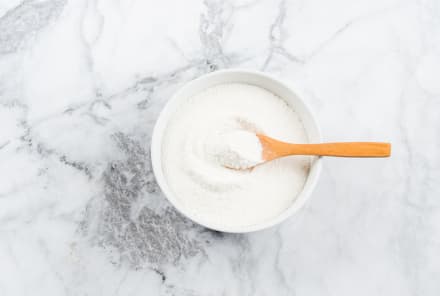Advertisement
Everything You Need To Know To Find & Use Your Ideal Carrier Oil


While smelling essential oils (either via a diffuser or straight out of the bottle) is enough to reap their aromatherapy benefits, applying them to the skin is another option. For that, you'll need a carrier oil.
The supporting actor to essential oil's star presence, carrier oils are subtle and understated but important to the success of the whole production. Here's a guide to the types of carriers out there and how to find and apply your perfect match.
What is a carrier oil?
Carrier oils are a substance that can, well, carry essential oils onto your skin. Essential oil expert, author, and teacher Amy Galper defines them as any sort of lipid-rich extract that can be expelled from a seed, nut, or fruit. Read: They're the fatty, rich plant oils that you probably already have in your kitchen.
Essential oils, on the other hand, are made from the isolated aromatic compounds of a plant, which are fragrant but volatile. They're really concentrated—but also really prone to evaporate quickly, so they can't be absorbed by the skin like a carrier oil can.
"If we want to apply an essential oil to our physical body, the only way we're going to get it in our body to make physiological change is to mix it in with something that it dissolves in well," Galper tells mbg. That's where the carrier comes in, which does double duty of feeding and nourishing the skin while helping deliver the therapeutic properties of essential oils.
Carrier oils are also important from a safety perspective. Since essential oils are so potent, they can irritate (and in some cases, really do damage to) the skin when applied on their own, or "neat" as it's known in aromatherapy land.
"It's not advisable to put essential oils directly on your skin," Galper stresses. "It's always recommended, for safety measures, to add or dilute them down in a carrier oil."
Vannoy Gentles Fite, author of Essential Oils for Healing, adds that diluting essential oils in a carrier oil will also help them last longer. This means that there's a financial case for carrier oils—most of which are more affordable than the essential oils they transport.
How to use carrier oils.
"Carrier oils are great for all kinds of applications," says Galper. If you have essential oils and a carrier on hand, you can DIY pretty much any skin, hair, and body product you can imagine: From whipped body butters to homemade deodorants, face rinses to foot scrubs, there's a carrier combo for that.
Before you get mixing, know this one important ratio: five to eight drops of essential oil per tablespoon of carrier oil (or 10 to 16 drops per ounce of carrier oil). Since essential oils are so concentrated, you really don't need much of them before you start feeling their effects. This is Galper's go-to formula for dilution—a ratio that has enough oils to pack a punch but not so many that it could damage skin.
Simply add the two oil types together in a bottle or roller-ball (amber glass is best for protecting the sensitive essential oils), shake to blend, and apply.
Galper adds that those who are new to essential oils or will be using the blend on sensitive skin should stick to the lower range or even dip to four to six drops per tablespoon first, see if the smell and feel of the oil is to their liking, and slowly work their way up from there. "You can always go up, but I would never go above 15 drops in a tablespoon," she says.
Types of carrier oils.
There are hundreds of plant oils that could work as carriers, but these nine get the highest marks from aromatherapists, dermatologists, and estheticians—aka the people who know.
Best for face:
These carrier oils are on the lighter side and gentle enough to put on your face. Use them to soak up clarifying essential oils like frankincense, German chamomile, or tea tree for a fresh glow:
- Jojoba oil: Extracted from the seeds of the Simmondsia chinensis shrub native to the Southwestern U.S., this funky-sounding oil (pronounced huh-hoe-buh) is Galper's all-time favorite. "Chemically it almost resembles more of a liquid wax so it's probably the most stable carrier oil that you can find—it doesn't oxidize," she says. Plus, "the chemical composition of jojoba is almost identical to our own sebum—the oil that our skin naturally produces—so our body immediately recognizes it." This means that it won't feel too greasy to the touch and is light enough to apply on the face. Plus, jojoba oil has a mild smell that won't compete with your essential oils.
- Argan oil: Another popular carrier oil for the face, argan oil comes from the argan tree in Morocco. It also has a mild scent, though it's slightly nuttier on the nose than a jojoba. Thanks to its natural anti-inflammatory1 properties, this one can also help reduce wrinkle formation and scarring while nourishing the skin. It's also a great hair oil.
- Apricot kernel oil: If you have flaky, itchy skin, psychologist and natural beauty expert Leigh Winters, M.A., M.S., says that the oil of apricot kernels "may just be your saving grace." "While this pale golden and odorless oil is suitable for all skin types, it has an affinity for exacerbated and dry skin. Plus, it has a very light texture that absorbs easily," Winters wrote on mbg.
- Rosehip seed oil: This striking orange-red oil is extracted from the pods of wild roses, and it captures some of the soothing, feel-good qualities of the plant and plops them on your skin. "Rosehip oil is a fantastic moisturizer that does not break people out. It's good for all skin types, especially dry or rosacea-prone," dermatologist Cybele Fishman, M.D., previously told mbg.
Best for body:
Carrier oils that are going to be used on the body can be slightly heavier than face oils. They should also be affordable enough to use in higher quantities. Combine them with essential oils like lavender for a soothing massage or peppermint for a quick pick-me-up.
- Olive oil: Yes, you can lather the kitchen staple on your body (just make sure it's high-quality; more on that below). It's rich in antioxidants that your skin will love, but beware that it does have a slight odor.
- Fractionated coconut oil: Another affordable, multiuse oil, fractionated coconut oil—which is free of the strong coconut scent—is rich in skin-nourishing vitamin E.
- Sesame oil: Beyond adding a hit of flavor in the kitchen, sesame oil (not the toasted kind) is also a popular topical pick. Its use in Ayurvedic abhyanga self-massage goes back centuries, and it's a go-to warming oil for the cold, dry vata dosha. Gentles Fite, a vata, can't get enough of it: "Sesame oil is very grounding, and it calms me. I generally use that a lot," she says, adding she'll regularly massage it onto skin with or without an essential oil in tow.
Best for hair and scalp:
Finally, carrier oils can be rubbed on the head to nourish the scalp and strands. Doctor them up with lemon or rosemary essential oil to promote hair growth or patchouli and palmarosa to tackle dandruff.
- Almond oil: The protein, vitamins, and fatty acids in almond oil make it a great one for promoting softer, stronger hair.
- Avocado oil: Avocado oil is a top pick for anyone with dry, damaged hair. mbg's senior beauty editor Alexandra Engler explains why: "Avocado oil is extremely rich in oleic acid and monounsaturated fats, making it one of few oils that can actually penetrate the hair shaft and moisturize your hair rather than sitting on top and coating your hair."
A note before you buy.
When looking for a carrier oil, quality is key. You're going to be lathering the stuff on yourself, after all! "It's the same kind of criteria that we use for eating. You want something that's organic," explains Galper, adding that your oil of choice should also be cold-pressed or expeller-pressed, signaling that no heat was added during processing that could have messed with the oil's quality. Finally, make sure that the oil is 100% made from the plant you think it is and not thinned out with another, cheaper carrier oil.
The bottom line.
To recap: Carrier oils allow you to apply essential oils to your skin, and there are hundreds of plant oils that could be used as carriers. Whichever carrier oil you choose, make sure it's organic and cold-expeller pressed. Add five to eight drops of your essential oil of choice to a tablespoon of carrier, and go forth to slather onto your face, body, and hair.
Watch Next
Enjoy some of our favorite clips from classes
Enjoy some of our favorite clips from classes
What Is Meditation?
Mindfulness/Spirituality | Light Watkins
Box Breathing
Mindfulness/Spirituality | Gwen Dittmar
What Breathwork Can Address
Mindfulness/Spirituality | Gwen Dittmar
The 8 Limbs of Yoga - What is Asana?
Yoga | Caley Alyssa
Two Standing Postures to Open Up Tight Hips
Yoga | Caley Alyssa
How Plants Can Optimize Athletic Performance
Nutrition | Rich Roll
What to Eat Before a Workout
Nutrition | Rich Roll
How Ayurveda Helps Us Navigate Modern Life
Nutrition | Sahara Rose
Messages About Love & Relationships
Love & Relationships | Esther Perel
Love Languages
Love & Relationships | Esther Perel
What Is Meditation?
Box Breathing
What Breathwork Can Address
The 8 Limbs of Yoga - What is Asana?
Two Standing Postures to Open Up Tight Hips
How Plants Can Optimize Athletic Performance
What to Eat Before a Workout
How Ayurveda Helps Us Navigate Modern Life
Messages About Love & Relationships
Love Languages
Advertisement

This Little-Known Supplement Helps Women Sleep & Decreases Signs Of Depression
Molly Knudsen, M.S., RDN

Want To Be Metabolically Healthy? New Study Shows An Underutilized Approach
Molly Knudsen, M.S., RDN

This Little-Known Supplement Helps Women Sleep & Decreases Signs Of Depression
Molly Knudsen, M.S., RDN

Want To Be Metabolically Healthy? New Study Shows An Underutilized Approach
Molly Knudsen, M.S., RDN













